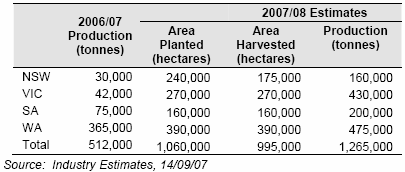Australia
September 17, 2007
Source:
Australian Oilseeds
Federation
Canola 2007/08
The canola crop has been impacted
by the very dry conditions through July/August. Estimates for
production have been reduced, with further downside to occur if
September continues to remain dry. Across the eastern states,
August was very dry and rain in the next week or two is
critical. Much of NSW and parts of Victoria hang in the balance
and if September remains dry, further area will be lost to hay
and yield potential will drop significantly.
 Given
the current state of the crop, it is difficult to determine
likely area harvested and yields accurately. This month’s
estimates still have the crop at around 1.2 million tonnes,
which is seen as possible if conditions return to average
rainfall for the remainder of the season. However, industry
estimates already have the crop at closer to 1 million tonnes
and further downside is possible. Without rain in the next week
or so, yields will be reduced. Variance around the estimates is
discussed in the specific State comments. Given
the current state of the crop, it is difficult to determine
likely area harvested and yields accurately. This month’s
estimates still have the crop at around 1.2 million tonnes,
which is seen as possible if conditions return to average
rainfall for the remainder of the season. However, industry
estimates already have the crop at closer to 1 million tonnes
and further downside is possible. Without rain in the next week
or so, yields will be reduced. Variance around the estimates is
discussed in the specific State comments.
The overall situation in New
South Wales is becoming critical as crops begin to run out
of moisture. The north western region which has received
scattered falls of rain over the past month has the best
prospects with the area being maintained at this stage. There
has been significant aphid activity with many crops requiring
spraying. In the central western region, the severe dry
conditions and lack of subsoil moisture have had a major impact
with likely area harvested being cut by up to 50% since August.
Most failed crops are being cut for hay or silage as growers try
to recoup some of their costs to date. In some districts crops
are too thin to be suitable for cutting for hay or silage and
have had stock turned in on them. Across the south west region,
there are very low to zero subsoil moisture levels even on the
more favoured upper slopes districts and unless widespread falls
of rain of at least 25mm are received within the next week many
more crops will fail. At this stage area harvested for the State
has been reduced to 175,000 hectares for production of 160,000
tonnes, however, this will fall rapidly if it continues to be
dry. Overall there is the potential of a further significant
down grading of the NSW crop and it is quite possible that
production could be 100,000 tonnes or less.
After an ideal start, the
potential for the Victorian crop has been hit by a record
dry winter. The rainfall decile for North West and parts of
North East of the state for August was 1 (i.e. lowest 10% of
rainfall records). In the Western district, August rainfall was
decile 2-5. Many crops were top-dressed too late, but the crops
in general have good moisture levels and are not stressed, after
6-10 mm rain this week, with further rain forecast. In the
Mallee, it is estimated that 10% of the crop has been lost and a
further 20% committed to hay. If there is no rain in the next
ten days, then it is expected that the vast majority of the crop
will be cut for hay. In the Wimmera, the yields have been cut
back by about 35% due to dry and warm, windy conditions. In the
North Central, crops are at full flower and could reach 1.5 t/ha
on average with an average finish. While yields across the State
have been reduced, the higher rainfall areas still have
reasonable potential and account for a significant proportion of
the area planted. The estimates presented here are viewed as
achievable if average rainfall is received for the remainder of
the season. However, there is considerable variance around the
estimates in Victoria and some industry players are calling the
crop as low as 260,000 tonnes, with other estimates ranging up
to 320,000 tonnes.
Crops in the low rainfall areas of
South Australia are struggling. While they were planted
early on good moisture, there has been little follow up rain. In
the medium to high rainfall areas, crops are still in reasonable
condition but it has been dry over the past month and thus, will
be relying on good rain to see them through. The potential for
hot windy days will further impact crops. Yields have been
revised down.
Estimates have been left unchanged
for Western Australia. The Southern Port Zones in WA are
going well and have received odd light showers over the past few
weeks, supporting their continued development. There are parts
of the Albany and Kwinana zone that are looking very good. The
Geraldton zone remains very dry, with little prospects for any
real production this season. The Esperance zone also recently
received some rain, but had a tough month previously, with
stored soil moisture being critical to support the crop. Good
spring rains are required to achieve potential.
Virtual canola site -
http://www.australianoilseeds.com/agronomy_centre/the_virtual_canola_site
|
|